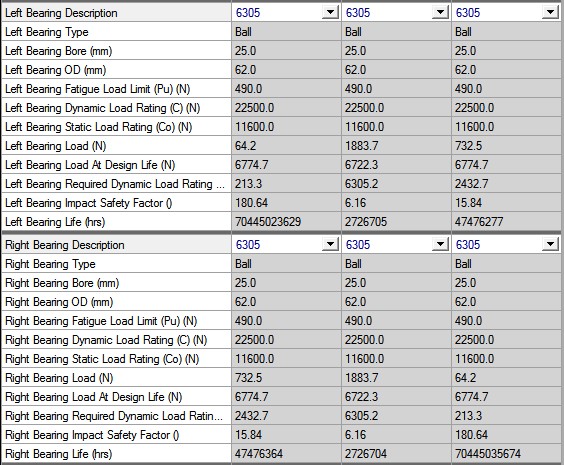|
<< Click to Display Table of Contents >> Bearing Definition Section |
  
|
|
<< Click to Display Table of Contents >> Bearing Definition Section |
  
|

The bearing definition section allows the user to define the two bearings that are on each roller (left and right as referenced from the idler drawing). The only user input is the bearing designation, all other data is displayed information about the selected bearing or calculated load and life information. The definition of each row within this section is as follows:
•Bearing Description – this is the deep groove ball bearing designation. The drop-down input contains a list of bearings which Idler Analyst can use as information to perform a calculation. This list of data covers 62, 63, and 64 series bearings from 20mm bore to 50 mm bore.
•Bearing Type – This displays whether the selected bearing is a ball or tapered roller bearing. Currently there are only ball bearings within Idler Analyst
•Bearing Bore – This is the inner diameter of the selected bearing.
•Bearing OD – This is the outer diameter of the selected bearing
•Bearing Fatigue Load Limit (Pu) – The fatigue load limit Pu of the selected bearing
•Bearing Dynamic Load Rating (C) – The dynamic load rating of the selected bearing
•Bearing Static Load Rating (Co) – The static load rating of the selected bearing
•Bearing Load – Given the orientation of the roll and the input capacity and belt weight, this is the calculated load on the bearing.
•Bearing Load at Design Life – This is the calculated load on the bearing in which the selected bearing reaches the input design life target.
•Bearing Required Dynamic Load Rating – This is the required dynamic load rating of a bearing placed where this bearing is located to achieve the target design life.
•Bearing Impact Safety Factor – This is the safety factor for which the selected bearing can handle predicted impact loads.
•Bearing Life – This is the calculated life estimated for the subject bearing given input loads orientation and failure probability percentage.